








Travel report Nepal August/September 2010by Stefanie ChristmannThe Esel-Initiative chairperson, Stefanie Christmann, spent almost six weeks in Nepal to look into the project in Dolpa. In order to counteract the climate impact of her flight, a contribution was made to www.atmosfair.de. All travel costs were donated by her. In surface area, Dolpa is one the largest districts in Nepal, yet it has only 35 000 inhabitants (west of the Dhaulagiri, bordering onto Tibet). The villages are separated by many steep mountain passes (often higher than 5 000 m) and rivers without bridges. At times one must walk for several days without passing a village or meeting anybody. It took me more than a week to reach Dolpa district. Nima S., a 37-year old widow from Tinjegaon, single mother of a son and director of the mothers’ group, said: “Many organisations have come here and promised help to the villages. But this is the first time we got any. Six weeks after the women were chosen, we got the naks!” Our co-operation partner Sahayog Himalaya-Nepal (SHN) has achieved amazing things: There are no banks in the region and only a few villages have a telephone. SHN trained Saput Sherchan and several other courageous and reliable men, equipped them with tents, sleeping bags and warm coats and sent them to Dolpa for several months. As the villages in the north mostly are located 3 500 to 4 300 m high, naks are the most suitable animals for allocation. Cows are not a qualitative alternative, but naks can live on mountain pastures. Thus, in this sparsely populated region, mothers’ groups must be initiated. SHN brought together all single mothers from every part of the village, some of which a day’s walk away, to initiate such groups and to agree on a set of rules on how to look after the animals: The mothers tend the naks themselves in rotation. All income from the naks (butter, schurpi/hard cheese made from buttermilk, wool) and their offspring is shared – as well as all risks. This is how 55-year old grandmother Pema G. from Simegaon received a nak. She looks after her small grandchild on her own, but is too frail to tend animals on high pasture or to work as day-labourer. She makes a living from weaving and spinning. The other women of the group take over her herding duties – and Pema receives an equal share of butter, schurpi and in four years time, when the first adult male calves will be rented out for trade in Tibet, she will receive her share of money. A yak in Tibetan trade will earn 1 000 rupee/day, more than the income form six days of labour. Thirty-year old Oser D. from Saldang, who is a single mother of a five year old daughter and who will be without a roof over her head when her brother marries, got her nak under the same agreement. In a few years she will be unable to herd animals or work as a day labourer since she is progressively going blind. Even if a nak is killed by wolves, bears or snow leopards, the mother will remain a member of the group and continue to do herding duty and receive the same share. In this way, the mothers of the group provide security for each other. The group decides when to sell a calf. But all of the groups want to keep the calves to increase the herds. 1 kg nak butter will fetch 600 rupees (6 Euro), 1 kg schurpi 150 rupees and each calf increases the income potential. Naks will be in calf after four years (until age 24) and they are used as working animals from age 4. The income from the sale of butter and schurpi is only used for the mother and her children, i.e. for school, warm clothing, better food or better housing eventually. Each group has a group leader, who together with the teacher ensures that all daughters and sons attend school. Many children, even at age 10 or 12, never went to school and have been or will be enrolled now. In the north of Dolpa, polyandry still exists. Also, many men are involved in trade and are far away from their villages and only a few women are able to marry. The men in Dolpa are heavy drinkers. According to Saput, women are exposed to a lot of domestic violence. Many of the unmarried mothers are very young, without any possessions or security. They all do hard field labour, carry wood and work on building sites. Chörtel G. from Charka, divorced for seven years, even collects goat droppings to swap for food, a most tedious work. In no other Himalaya region did I meet so many mothers who out of poverty send young children to monasteries or off to work: because they are unable to feed all their children. Lamu G., for example, a 40-year old single mother of three from Tinjegaon, sent her oldest daughter at age 12 to a another household where the girl has to herd animals, collect wood (very hard labour) and work in the fields in exchange for bed, food, clothing and about 45 kg barley every year for her mother. Lamu explained that this was the only way to keep her smaller children alive. With her small children Lamu lives in a space of 8 sqm, she owns no land. She has leased a potato field, but has to hand over half of the harvest to the owner. In good years, there are enough potatoes for three months. The family mostly survives on barley soup. Widows have a very hard life. Some may inherit a house and a bit of land, the harvest of which may last for some months. However, they need lots of tsampa (barley and butter) for their husband’s funeral. Phonso G. from Charka, for example, owes 30 000 rupees which can only repay through day labour (equivalent to 100-150 rupees/day). But every day working without pay is a lost day for feeding the family. Her four small fields provide only enough food for five months. Like many other mothers, she has to borrow food in winter. The commitment of some of these women has impressed me tremendously: Pema G., a 39-year old single mother of five children under the age of 11, has built her own small house. To pay for the timber (which has to be transported by yaks from Tibet to northern Dolpa) she collected Yarsangumba (rare mushroom which is sold to China). She leased five fields (half of the harvest pays for the lease) and for eight months she does not need to purchase barley or potatoes. In these months, her day labour job provides additional food for her children. Also the group leaders impressed me very much. Most of them have campaigned for women in the past. In January, they will participate in the next midwifery training in Kathmandu and afterwards receive a horse. Unfortunately, in the current project villages in Dolpa we only found one woman who has been to school. She will also participate in the midwifery training. All other participants from Dolpa are illiterate. There are very few health centres in Dolpa and these are only open during summer. The mortality rate of mothers and newborn babies is dramatic: In Simegaon, 9-10 children are born in a year with 1-2 mothers dying in childbirth. In Tinjegaon, during the 20 births per year, ten babies are either born dead or die shortly after. Many mothers survive birth but die shortly after due to infections. Some participants of the first training course had acted as midwives in the past but had never even seen professional obstetrics. The female doctor who teaches the course explained that many did not know how touch the abdomen of a pregnant woman to establish the foetus’ position, they did not know how to listen to the baby’s heartbeat, did not even know how to check the pulse, calculate the date of birth, or create a clean environment for the delivery. They had no idea about proper breathing during birth, how to correctly cut the umbilical cord, get the newborn to breath, how important it is to deliver the afterbirth completely and that follow-up visits are indispensible etc. All this is taught in the midwifery training. While it will not teach the women to perform a breech delivery etc., the training will drastically lower the risk of infection during and after birth, considerably improve survival of mother and child and enable timely transfer of women with an expected difficult delivery to a health centre (if open). All participants receive an aluminium case with stethoscope, disinfectant, sterile gloves, scissors etc. which they can replenish in the health centres. I met two midwives who did the first training course, 27-year old Sunita T. from Dana (Myagdi) and 32-year Pema B. from Tsarang (Upper Mustang); Pema had to ride hard for four days to meet us. Both are married, Sunita has two children. For years she had attended “midwifery courses” in the health centres but never learnt about obstetrics, only about infant care, vaccines etc. and before she participated in our training, she only did infant care. Sunita did not receive a horse because she will work solely in Dana. From there, she can get women with expected difficult deliveries transferred to a hospital. By request of the districts, our first midwifery training was also attended by women who are now responsible for a larger village with more deliveries than in the smaller villages – and who do not need a horse. Nine women from Upper Mustang, seven from the high mountain region below Manaslu, three from Manang, one from Lower Mustang and two from Myagdi successfully participated in the training. Afterwards, 11 received a horse – just as Pema did. Pema is responsible for Tsarang and Marang in Upper Mustang and will, if necessary, ride as far as Dakmar. Pema has no children. She has been campaigning for the women in Tsarang for years and to become a midwife has been her wish since childhood. This course was her chance. She is fascinated by her new voluntary work (midwives do not receive payment). She records all events during the pregnancies and the deliveries. She has attended two deliveries in Marang and three in Tsarang. Two of the newborn babies were unable to breath unassisted. One delivery was very hard and lengthy. Pema was able to handle all difficulties. She intends to transport pregnant women with a foreseeable difficult birth with her horse to the hospital in Gami, across the Choya pass (3870 m). – Both midwives report that the pregnant women are delighted to finally have a midwife with better skills und that they eagerly follow instructions to prepare what is required for a sterile homebirth. SHN wants to continue offering basic training for midwives from different regions and possibly enable further training to the most talented. |
Other travel reports:
August 2011
February 2009
September 2008
September 2007
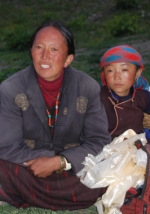
33-year old Tsiring P. L. is the leader of the mothers’ group in Saldang. She has been involved for many years in the school committee; she is a single mother of a nine year old daughter.
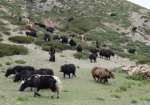
Tsiring and Nima L. have brought the nak and calf herd from Saldang downhill for a day so that we could take this picture – and I walked uphill for one day to meet them.

Some of the mothers from Saldang, who received a nak, with some of their children. In Saldang we built two herds (and two mothers’ groups) with 21 and 16 naks, respectively.

Grandmother Pema G. makes her living from spinning and weaving and is supported by the mothers’ group. Pema’s 7-year old grandson was the brightest child I met in Dolpa.
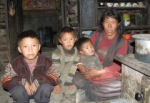
Nisang G. from Simegaon, a 44-year old widow with three small sons and a mountain of debt from her husband’s funeral.
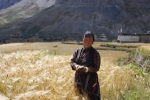
Chörtel G. on her small barley field.

Lamu G. with her youngest daughter in her dark and cold dwelling.

The nak herd in Tinjegaon was not amused when the women brought them from their lush hill pastures down to take this picture.

Chimba C. G. from Charka sorts her potato harvest. The yield is low.
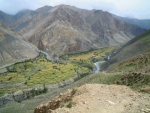
Saldang
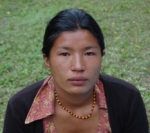
Midwife Sunita T.

Midwife Pema B. from Tsarang: shortly before her arrival in Kagbeni – after a fast two day ride.
home | the project | news | on tour | on site | ideas | partners | the board | help | mail
Account No. 106 57575 - Sparkasse KölnBonn - BLZ 370 501 98
For donations from outside Germany - IBAN: DE02 3705 0198 0010 6575 75 - Swift-BIC: COLSDE33
please only bank transfers in Euro, no checks!